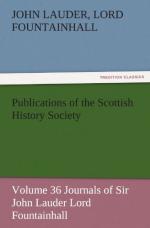advice of their Lyon King of Arms, Mr. Balfour Paul,
had offered as a gift to this Society those very important
genealogical documents, the Macfarlane documents, which
had been lying in the Advocates’ Library,
and to which a great many people at various times
had been referring, to such an extent that he believed
Mr. Clark, the librarian of the Advocates’
Library, had been almost incommoded by the number
of such applications. Henceforth this would not
be the case, as the Macfarlane genealogical documents
were to be published under the editorship of Mr.
Clark. That was a windfall for which he had
no doubt all the members of the Society would be thankful,
and when he moved the adoption of the report he meant
specially to propose their adoption of a hearty
vote of thanks to the trustees of Sir William Fraser.
Professor MASSON then alluded to the proposal of Mr. C. Stanford Terry to produce the silent records relating to the union of Scotland with England in the years 1651 to 1653. That was a portion of Scottish history that had been almost forgotten, but a very important and interesting portion of Scottish history it was. In 1651, after the battle of Dunbar, and after Cromwell’s occupation of Scotland, and after he had gone back to England and had left Monk in charge in Scotland, with about eight thousand Englishmen in Scotland, distributed in garrisons here and there, it occurred to the Long Parliament of England, then masters of affairs in Great Britain, that there ought to be an incorporating union of Scotland with the English Commonwealth. That proposal came before the Long Parliament in October 1651. It was agreed upon, by way of declaration, that it might be very desirable, and a committee of eight members of the Long Parliament was appointed to negotiate in the matter. They came to Scotland, and there was a kind of convention, a quasi Scottish Parliament, held at Dalkeith, where the matter was discussed. Of course, it was a very serious matter, giving rise to various feelings. To part with the old Scottish nationality was a prospect that had to be faced with regret. To this Parliament the Commissioners proposed what was called the Tender, or an offer of incorporating union. The variety of elements in Scotland— Royalists, Presbyterians, Independents—in the main said that they must yield, although they were reluctant. Even those who were most in sympathy with the English Commonwealth politically shrank for a while, and they tried whether the Long Parliament might not accept a kind of compromise, whether Scotland might not be erected into a little independent Republic allied to the English Commonwealth or Republic. But at last all these feelings gave way, and the English Commissioners were able to report before the end of the year, or in January—what we should now call 1652, but then called 1651—that twenty of the Scottish shires out of thirty-five had accepted the Tender, and that almost all the burghs




